RBSE Class 11 Biology Important Questions Chapter 15 Plant Growth and Development
Rajasthan Board RBSE Class 11 Biology Important Questions Chapter 15 Plant Growth and Development Important Questions and Answers.
RBSE Class 11 Biology Chapter 15 Important Questions Plant Growth and Development
Multiple Choice Questions
Question 1.
The main effect of auxin to stimulate:
(a) Cell division
(b) Cell elongation
(c) Cell turgidity
(d) Cell differentiation
Answer:
(b) Cell elongation

Question 2.
Cytokinins stimulate:
(a) Cell division
(b) Cell elongation
(c) Cell turgidity
(d) Cell differentiation
Answer:
(a) Cell division
Question 3.
During senescence, an increase in:
(a) chlorophyll
(b) protein
(c) respiration
(d) abscisic acid
Answer:
(c) respiration
Question 4.
Which one of the following considered floral hormone?
(a) Auxin
(b) Gibberellin
(c) Cytokinin
(d) Abscisic acid
Answer:
(b) Gibberellin
Question 5.
The shape of geometrical growth curve is:
(a) Cuboid
(b) Sigmoid
(c) Linear line
(d) Triangular
Answer:
(b) Sigmoid
Question 6.
Embryo shows:
(a) Arithmetic growth
(b) Sigmoid
(c) Both (a) and (b)
(d) Triangular
Answer:
(c) Both (a) and (b)
Question 7.
Who performed Avena curvature test?
(a) Darwin
(b) Geometric growth
(c) Thimann
(d) None of these
Answer:
(b) Geometric growth

Question 8.
Factor responsible for seed dormancy is:
(a) Immature embryo
(b) Hard seed coat
(c) Impermeable seed coat
(d) All of these
Answer:
(b) Hard seed coat
Question 9.
Which of the following plant hormones is not found in natural plants?
(a) 2, 4 - D
(b) GA2
(c) Gibberellins
(d) IAA
Answer:
(a) 2, 4 - D
Question 10.
In callus culture, roots can be induced by the supply of:
(a) Auxin and no cytokinin
(b) Higher amount of auxin and lower amount of cytokinin
(c) Higher amount of cytokinin and lower amount of auxin
(d) Auxin and cytokinin in equal amounts
Answer:
(b) Higher amount of auxin and lower amount of cytokinin
Question 11.
The cause of Bekane disease of paddy field is:
(a) NAD
(b) 2, 4 - D
(c) GA3
(d) IAA
Answer:
(c) GA3
Question 12.
Apical dominance is not affected by:
(a) Indole acetic acid
(b) Gibberellins
(c) Indole acetaldehyde
(d) Indole butyric acid
Answer:
(b) Gibberellins
Question 13.
Chemical nature of kinetin is:
(a) Butyric acid
(b) 6 - furfuryl amino purine
(c) Indole butyric acid
(d) Indole acetic acid
Answer:
(b) 6 - furfuryl amino purine
Question 14.
Which of the following seed does not show dormancy?
(a) Rhizophora
(b) Cassia
(c) Phaseolus
(d) Xanthium
Answer:
(a) Rhizophora
Question 15.
Coconut milk is commouly used in tissue culture because it has
(a) Ethylene
(b) Cytokinin
(c) Gibberellin
(d) Auxin
Answer:
(b) Cytokinin
Question 16.
Which hormone is responsible for vernalisation?
(a) Abscisin
(b) Colchicine
(c) Vernalin
(d) Florigen
Answer:
(c) Vernalin
Question 17.
Photoperiodism was coined by:
(a) F.W. Went
(b) Garner and Allard
(c) F.W. Blackman
(d) R. Hills
Answer:
(b) Garner and Allard
Question 18.
Coleoptile represents:
(a) covering of radicle
(b) covering of cotyledon
(c) covering of plumule
(d) synonym of plumule
Answer:
(c) covering of plumule
Question 19.
Which one of the following growth regulators is known as stress hormones?
(a) Indole acetic acid
(b) Abscisic acid
(c) Ethylene
(d) GA3
Answer:
(b) Abscisic acid

Question 20.
Hormone responsible for senescence is:
(a) Abscisic acid
(b) Auxin
(c) Gibberellin
(d) Cytokinin
Answer:
(a) Abscisic acid
Question 21.
Which photohormone is used to stimulate morphogenesis during plant tissue culture?
(a) Auxin
(b) Abscisic acid
(c) Gibberellin
(d) Cytokinin
Answer:
(d) Cytokinin
Question 22.
The cause of abscission of leaves is:
(a) ABA
(b) Cytokinin
(c) Auxin
(d) Gibberellin
Answer:
(a) ABA
Question 23.
Photoperiodism was first discovered in:
(a) Tobacco
(b) Potato
(c) Tomato
(d) Cotton
Answer:
(a) Tobacco
Question 24.
Usually, used hormone in tea gardens is:
(a) ABA
(b) Zeatin
(c) IAA
(d) Ethylene
Answer:
(b) Zeatin
Question 25.
The cause of foolish seedling disease is:
(a) IAA
(b) ABA
(c) Cytokinin
(d) Ethylene
Answer:
(b) ABA
Question 26.
Which one is a weedicide?
(a) ABA
(b) IAA
(c) 2, 4 - D
(d) C2H4
Answer:
(c) 2, 4 - D
Question 27.
One of the following is not a long day plant?
(a) Radish
(b) Wheat
(c) Beet root
(d) Tobacco
Answer:
(d) Tobacco
Question 28.
Which one of the following is a day neutral plant?
(a) Maize
(b) Tobacco
(c) Chenopodium
(d) Xanthium
Answer:
(a) Maize
Question 29.
Which wavelength of light is responsible for best flowering?
(a) Red light
(b) Blue light
(c) Green light
(d) Day light
Answer:
(a) Red light
Question 30.
Which one of the following is a gaseous hormone?
(a) ABA
(b) Ethylene
(c) IAA
(d) Vernalin
Answer:
(b) Ethylene
Very Short Answer Type Questions
Question 1.
Define growth.
Answer:
A permanent and irreversible change in the size or volume of a cell, organ or whole organism accompanied by an increase in its dry weight is called growth.
Question 2.
What do you understand by plant growth rate?
Answer:
The growth occuring per unit time is called growth rate.

Question 3.
The length of sugarcane stem increase by spraying of which growth regulator.
Answer:
Gibberellins.
Question 4.
In which phase growth curve is most?
Answer:
Log phase.
Question 5.
Which plant hormone reduce growth?
Answer:
Abscisic acid.
Question 6.
Name the hormone responsible for parthenocarpy.
Answer:
Gibberellins.
Question 7.
Give one function of auxin.
Answer:
It stimutates growth in length is stem.
Question 8.
Which are three phases of cell growth?
Answer:
- Division
- Elongation
- Differentiation.
Question 9.
Name a physiological process in which Lactuca sativa is used.
Answer:
Germination.
Question 10.
Name instrument used for measuring growth.
Answer:
Auxanometer.
Question 11.
Name any three activities based on light.
Answer:
- Photosynthesis
- Photonasty
- Photoperiodism.
Question 12.
Give example of each LDP and SDP.
Answer:
LDP : Beet root.
SDP : Sunflower.
Question 13.
Which plant is used by Went for experiment?
Answer:
Avena sativa.
Question 14.
Which hormone is responsible to apical dominance in plants?
Answer:
Auxin.
Question 15.
In which plants gibberellin was discovered?
Answer:
In Gibberella fujikuroi fungi parasite of rice plant.
Question 16.
Where mostly photohormones are synthesised?
Answer:
In shoot apex.
Question 17.
Name the hormone related with cell division.
Answer:
Cytokinin.
Question 18.
What is chemical nature of cytokinin?
Answer:
N6 furfuryl amino purine compound.
Question 19.
Name the hormone used in checking germination in potato tuber.
Answer:
MCPA (2 - methyl, 4 - chlorophenoxy acetic acid).
Question 20.
What is vernalin?
Answer:
Vernalin is precusor of flowering stimulating hormone florigen, which is formed in seeds as a result of vernalisation.
Question 21.
What is vegetative growth?
Answer:
Growth which takes place between seed germination and preflowering phase is called vegetative growth.
Question 22.
Who first noticed the presence of auxin?
Answer:
Charles Darwin.
Question 23.
Who worked on coleoptile of Avena sativa.
Answer:
Boysen - Jensen (1910 - 1913).
Question 24.
Give one example of each natural auxin and synthetic auxin.
Answer:
Natural auxin : IAA
Synthetic auxin : 2, 4 - D.

Question 25.
Define vernalisation.
Answer:
Aquisiton of the ability of flower by chilling treatment is called vernalisation.
Question 26.
Write two uses of abscisic acid.
Answer:
- It induces flowering in some SDP.
- It can be used as an antitranspirant.
Short Answer Type Questions - I
Question 1.
Why a gardener decapitate the bush during hedge making?
Answer:
Many plants exhibit apical dominance. It means the growth of lateral buds remains inhibited in the presence of apical bud. An expert gardener removes, apical buds from the stems of bushes and lateral buds becomes active and grows fastly.
Question 2.
Give the chemical nature of Gibberellin.
Answer:
Abscisic acid is a growth inhibitor phytohormone found naturally in plants. It is also known as stress hormone because it helps the plant to cope up adverse environmental conditions.
Discovery of Abscisic Acid: Woreing at al extract a substance from leaves of Acer plant, which inhibit the growth of bud and germination of seeds. He was called it Dormin. Carn and Adicat (1961 - 1965), extracted a substance from flower bud of cotton plant and named it abscisin which on spraying on any plant causes degradation in leaves.
It was later on, realised that abscisin and Dormin are one and same thing. Therefore, a common name abscisic acid was given to both. Chemical Nature of Abscisic Acid: Abscisic acid also called ‘ABA’ or terpolinic acid. Its chemical formula is C15H2O4. Chemically they are terpinoids. This group includes only one growth regulator so known ABA. ABA mainly synthesised in chloroplast in the scarcity of water form degradation of carotenoids.
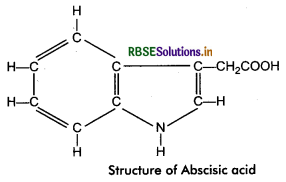
Physiological Effects and uses of Abscisic Acid
- Abscission of leaf: In leaves ABA induces leaf abscission with the help of ethylene. It alone induces abscission in flowers and fruits. Due to which leaves and fruits are fall down.
- Antitranspiration Process: ABA effectively closes stomata. Actually abscisic acid checks influx K+ ions in guard cells. This decreases their osmotic potential and stoma close. Thereby transpiration is checked.
- Inhibition of growth: Abscisic acid is a strong growth inhibitor. It inhibits growth of coleoptile of Avena upto 50% at 10-6 M concentration.
- Senescence: Main function of abscisic acid is to promote senescence in leaves and other plant parts. It stimulates the breakdown of chlorophyll in the leaves.
- Dormancy of Buds and Seeds: Dormancy of many types of seeds and buds can be increased by the use of abscisic acid.
- Tuber formation in Potato: ABA increases tuber formation in potato.
- Effect of the synthesis of α - amylase enzyme: ABA inhibits the synthesis of a-amylase enzyme due to which germination of grains is checked.
- Flowering: ABA has indirect effect on flowering. Flowering is affected by relative amount of ABA and gibberellin. In Cannabie sativa abscisic acid checks formation of male flower induced by gibberellins in female plants.
Question 3.
Give the chemical structure of auxin.
Answer:
Kogl (1931) and Thiman (1935) isolated a substance from human urine, which is called auxin-a (auxentriolic acid; C18H32O5). Kogl and Coworkers (1934) isolated a similar substance from corn germ oil and named it auxin - b (Auxenolonic acid: C18H30O5). Auxins are of two types:
1. Natural Auxins: Kogl and co - workers again isolated third type of from human urine and called it heteroauxin. Now a day is called IAA (Indol 3 - acetic acid). It is a natural auxin found in plant. Other natural auxins are derivatives of IAA. Natural auxins formed in apical meristem and they are synthesised by aminoacid triptophan in meristematic region. They move from apex to base. Their transport is basipetal and their quantity is maximum in apical meristems. In high light intensity, they are denatured.
2. Artificial Auxins: Many substances having IAA like physiological response have been synthesised in the laboratories. They are called synthetic or artificial auxins. Synthetic auxins are called growth regulators instead of phytohormones. Some artificial or synthetic auxins are as follows:
- Indole Butyric Acid (IBA).
- Naphthalene Acetic Acid (NAA).
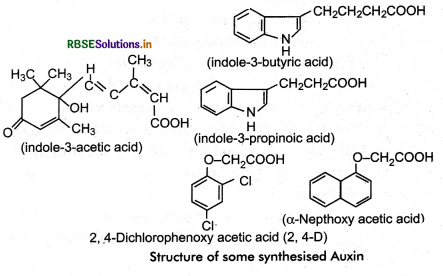
- 2, 4 - Dichlorophenoxy acetic acid (2, 4 - D).
- 2, 3, 6 - Trichloro benzoic acid (2, 3, 6 - T).
Question 4.
If the apical bud of a seedling put of then its growth is checked. Why?
Answer:
At apex of stem, a phytohormone synthesised from meristematic cells, diffused to other part of the plant. Due to this hormone cell division and growth occur in cells. When apical bud of plant is removed the growth and cell division are inhibited.
Question 5.
Write short note on senescence.
Answer:
Senescence or biological aging is the gradual' deterioration of functional characteristics. Abscisic acid and ethylene stimulate senescence while cytokinin delays senescence.
Question 6.
What is apical dominance?
Answer:
Apical dominance means the growth of lateral axillary buds remains inhibited in the presence of apical bud. Growth in axillary buds starts as soon as apical bud is cut.
Question 7.
Write agricultural uses of auxins.
Answer:
Agricultural uses of auxins:
- Synthetic auxin 2, 4 - D is used as weedicide in crops.
- NAA is used to stimulate seedless fruit formation.
- NAA is also used to inhibiting sprouting of potato.
Question 8.
What do you understand by bolting effect?
Answer:
Some plants are biennial and show rossetic habit during first year. Their leaves spread over ground. Spray of gibberellins on these plants causes quick elongation of nodes but leaves are not produced. This elongated long leafless internode is called bolt and this phenomenon is known as bolting effect.
Question 9.
Give agricultural uses of gibberellins.
Answer:
Agricultural uses of gibberellins:
- Gibberellins are used in the production of Thompson’s seedless grapes.
- They are used to increase the amount of a - amylase in barley.
- They are used to increase the size of sugarcane plant and sugar yield.
- They are used to improve the quality of some fruits.

Question 10.
Give two uses of cytokinins.
Answer:
Uses of Cytokinin:
- Tissue culture: Cytokinins are essential for tissue culture as they not only promote cell division but also help in morphogenesis.
- Delay in senescence: Ripe vegetables, flowers and fruits can be kept fresh for longer period it treated with cytokinin.
Question 11.
Write two uses of ethylene.
Answer:
Uses of Ethylene:
- Ethylene helps in artificial ripening of many types of fleshy fruits.
- Application of ethylene increases number of female flower in cucurbits. Therefore, the number of fruits also increases.
Question 12.
Write the uses of abscisic acid.
Answer:
Uses of Abscisic acid:
- It induces flowering in some short day plants.
- It can be used as an antitranspirant.
- Dormancy period of many seeds and buds can be increased by using abscisic acid.
- In Cannabis sativa abscisic acid checks formation of male flowers.
Short Answer Type Questions - II
Question 1.
What are plant hormones? Who discovered plant hormone? Name various phytohormones.
Answer:
Plant hormone or phytohormone: The chemical substances those are produced in one tissue or organs of the plant and sent to other parts for growth and development. These substances are called plant hormones. The word hormone was first of all used by Starling in 1906. J.V. Sach first of all discover plant hormone and called them growth factors.
The plant hormone are divided into five groups:
- Auxins: Such as indole acetic acid, indol butyric acid.
- Gibberellins: Such as GA, GA3.
- Cytokinins: Kinetin, zeatin etc.
- Abscisic acid: ABA
- Ethylene: gaseous hormone.

Question 2.
Write short note on abscission.
Answer:
Abscission: Abscission (from latin ‘ab = away’ and ‘scindere = to cut) is shedding of various parts specially leaves and fruits of plant. Due to various causes such as drought, lack of nutrients, senescence, deficiency of light etc., the formation of ethylene and abscisic acid increases thereby a abscission layer is formed at the base of pedicle and petiole. This layer checks the transportation of materials between plants and leaf/fruit. After some time this leaf/fruit is isolated from plant. The isolation of fruits after ripening is caused so. IAA hormone delays abscission and senescence. If IAA in appropriate concentration would sprayed them abscission is delayed for a time.
Question 3.
Write differences between hormones and enzymes.
Answer:
Differences between Hormones and Enzymes.
|
Hormones |
Enzymes |
|
1. There are generally produced in meristems and are transferred from one place to other through phloem. |
1. They are synthesised in cells according to their need. |
|
2. Their chemical nature is different. |
2. All enzymes are proteinaceous in nature. |
|
3. Their effects are different accordingly their concentration. Example: Auxin, Abscisic acid. |
3. There is no effect of enzyme concentration. Example: Aldolase, Hexokinase etc. |
Question 4.
How auxin and cytokinin stimulate differentiation in tissues in plants.
Answer:
Cytokinin have the ability to change morphological nature. For instance a callus developed from the pith cells of tobacco, can be made to develop into root or shoot by changing concentration of cytokinins and auxin. When pith cells of tobacco are cultured in medium containing minerals and sugar only callus formation occurs. When less concentration of cytokinins than auxin is used, only root develops from callus. Intermediate ratio of auxins and cytokinins stimulates formation of both root and shoot, while in intermediate cytokinin and low auxin concentration only callus formation takes place.
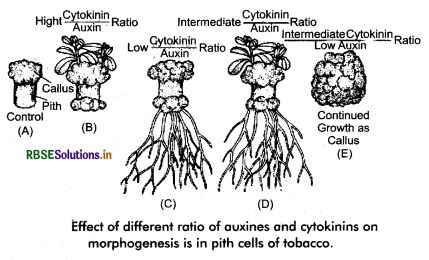
Question 5.
Give the reason:
(a) Blow of flowers.
(b) However fruits drop down before maturity.
(c) To made hedge of Durenta and Myrtle plant, the bushes are decapitated.
Answer:
(a) Flowering in plants is affected by light. The plants required light for a definite duration per day to flower. It is called photoperiod or flowering period. In the presence of light a hormone florigen is synthesised, which is responsible for flowering.
(b) However, the concentration of abscisic acid in pedicels of fruits increases thereby abscission of fruits takes place.
(c) There auxin is synthesised in apical bud of Durenta and Myrtle plants, which checks the growth of lateral axillary buds, thereby bushes are not formed. By decapitating apical bud, the synthesis of auxin automatically ceases, and axillary buds starts to grow.
Question 6.
What is the role of gibberellin in germinating seeds of grain?
Answer:
During germination of grain seeds, they absorb water thereby the synthesis of auxin being start in embryos of seeds. Gibberellin stimulates the synthesis of proteases and α - amylase enzymes. It activates inactive α - amylase. Active α and ß - amylase combine to digest starch to form glucose. The energy is released by oxidation of glucose for embryo. Now cytokinin and auxin are also synthesised thereby cell division, differentiation and elongation become start and seedling is formed.
Question 7.
Write short note on forming sites of plant hormones.
Answer:
- Auxin: It is synthesised in meristematic tissue specially in apical meristem. Its transportation from one place to other is done by diffusion. The flow of auxin is unidirectional.
- Gibberellin: It is synthesised in young leaves, buds, seeds and roots. It transported by xylem and phloem. It affects whole of the plant.
- Cytokinin: It is mainly formed in root apices or germinating seeds. They transported from root to stem through xylem.
- Abscisic acid: They synthesised from carotenoids. They transported in whole plant through xylem, phloem and parenchyma.
- Ethylene: It is formed from amino acid methionine. It released to air from senescent flowers, ripened fruit, shoot apex, roots etc. It transported by air.
Question 8.
Write some important characteristics of phytohormones.
Answer:
Characteristics of Phytohormones:
- All phytohormones are organic substance in nature.
- They regulate the growth, development, differentiation of plants.
- They are generally formed at the apices of root stem and leaves.
- They are translocated from one organ to other through xylem and phloem.
- They are required in very little amount.
- They affects all events in the life cycle of a plant like seed germination, flowering, dormancy, senescence, movement and growth etc.

Question 9.
Write short note on the mechanism of cytokinin action.
Answer:
Mechanism of cytokinin action: There are enough evidences to prove that cytokinin stimulate cell division by affecting nucleic acid metabolism and protein synthesis. Though exact mechanism of their action is not known, it has been found that cytokinins increase internal production of sugar and other solutes, thereby retarding yellowing of leaves due to senescence. In addition, cytokinins affect synthesis of some specific enzymes necessary for synthesis of specific amino acids and check protein degradation during senescence.
Question 10.
Write the importance of vernalisation.
Answer:
Importance of Vernalisation:
- By vernalisation, duration of vegetative phase is reduced. The seeds produced after vernalisation are shiny, healthy and bulky, therefore, crop yield is increased.
- There are more chloroplast in leaves produced by vernalized plant, hence, the rate of photosynthesis increases.
- Biennial plants can be made to flower in one year only.
- Vernalisation has been seen to increase drought resistance, cold resistance and disease resistance in plants.
Long Answer Type Questions
Question 1.
What do you mean by dormancy? Write the causes of dormancy of seeds. Give the methods of breaking seed dormancy.
Answer:
Dormancy: Dormancy is a stage of plant or a part of plant in which its active growth is temporarily inhibited. In other words, the state of temporary ceasation of growth and metabolism of a plant or plant part is called dormancy.
Causes of Dormancy of Seeds:
- Hard seed coat: In many seeds hard seed coat causes dormancy. This hard seed coat is impermeable to water or gases. In some seeds, the seed coat is so hard that it does not break even by the emerging embryo.
- Dormant embyro: Some apparently healthy seeds remain dormant due to some physiological disturbance.
- Immature embryo: Some seeds are apparently healthy but do not germinate as they have immature embryo. Actually, development of embryo is not completed in these seeds due to some unknown factors.
- Germination inhibitors: Many chemical substances have been isolated from seeds which inhibit seed germination.
Methods of Breaking Seed Dormancy:
- Scarification: Dormancy caused by hard seed coat can be broken by this method. In this seed coat is mechanically broken or rendered weak by scratching it to facilitate germination.
- Pressure: Seeds of some plants are given hydraulic pressure of 2000 atm at 18°C temperature for 5 - 20 minutes to make the seed coat permeable, consequently water starts entering the seed and dormancy is broken.
- Low temperature: Dormancy of some seeds can be broken by treating them with low temperature.
- Light: Seeds of some plants germinate in bright light. Exposure of light helps in breaking dormancy in such seeds.
Question 2.
How growth is measured? Write the mechanisms of any two growth measurement devices.
Answer:
Plant growth is measured as an increase in weight or length or volume. The measurement of growth of plant can be done by following ways:
- growth in length
- growth in thickness
- growth in region and volume
- growth in number of cells.
Any of method is used for measurement of plant growth. But for correct information we should take many measurement. For example, at the time of seed germination dark condition is required, thereby it get fast growth but at the same time there is a reduce in its dry weight because stored food is utilized in growth in length.
The growth can be measured by following method:
1. Direct Method: This is a most simple method. To measure growth by this method, the growing part of plant is marked and after interval it is measured by scale.
2. Arc Auxanometer: Arc auxanometer has a pulley fitted on an vertical stand. A thread is tied on the apex of plant, whose length is measured and the thread is passed over the pulley. A pointer is attached to the pulley which moves on a scale. Some weight is tied on the free end of the thread. When stem of plant grows in height the weight attached on thread moves downwards leading to movement in pulley. As the pointer is attached to pulley it also moves on a pointer scale. Its reading represents growth of plant in height.
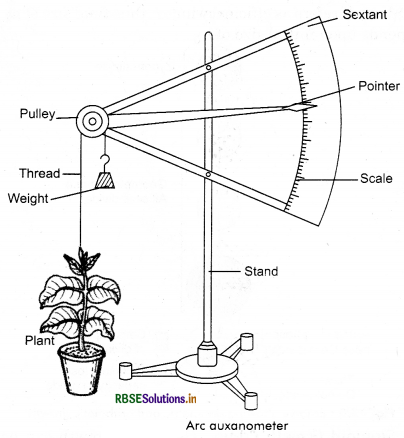
3. By horizontal Microscope: In this method, growth of plant in length is measured with the help of a horizontal microscope which slides over a graduated vertical stand. A particular point marked on the growing tip is focussed. After a gap of time the microscope is moved to focus it again and the distance covered by the microscope (as indicated on the vertical scale) is equivalent to increase in the length of the plant.

4. Pfeffer's Auxanometer: It consists of a revolving drum and two pulleys and two wheels, small and large, the smaller one being attached to the central axis of the large one on one side. A thread tied to the stem apex is hung around the small wheel and its other end is tied to a weight. Similarly a thread is hung on the large wheel, with both the ends tied with weights. An indicator is attached to the weight of the thread on one end to trace a line on the smoked paper posted around the drum, which is kept in rotation (once ever hour) by a clock work.
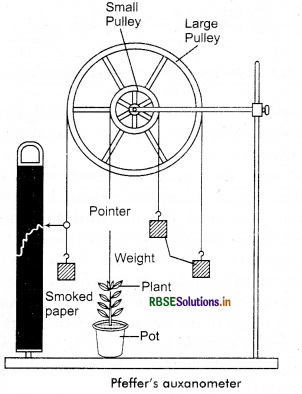
Growth in stem tip lowers the weight to which the indicator is attached resulting in a special marking going downwards on the smoked paper. The perpendicular distance between two adjoining markings on the paper indicates the hourly growth. The actual growth can be calculated by taking into consideration the rotation of the drum and the radii of the small and the big wheels.
Question 3.
Describe photoperiodism and critical photoperiod.
Answer:
Light has much importance for different activities in plants. The duration of light affect proliferation, growth, flowering of plants. The response against duration of light and time by plants is called photoperiodism. Garner and Allard (1920) observed that plants of Maryland mammoth variety of tobacco do not flower in the absence of a critical duration of light even if provided with all other necessary requirements. They called this phenomenon photoperiodism. They told that this species of tobacco grown in summer season, it grows well vegetatively only but this species grown in winter season, it grows well along with flowering. Duration of light required for flowering is known as day length or photoperiod.
Garner and Allard classified the plants into three main groups on the basis of photoperiod:
- Short day plants (SDP)
- Long day plants (LDP)
- Day neutral plants (DNP).
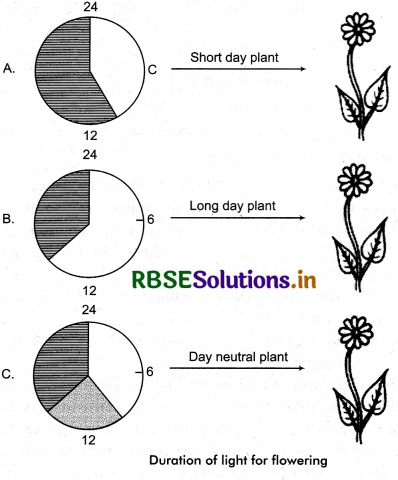
1. Short Day Plants (SDP): These plants require comparatively short duration of light for flowering. In these plants the photoperiod must be less than certain critical period. For example Maryland mammoth variety of tobacco needs less than 2 hours of light and more than 12 hours of dark. Chenopodium, Glycine, Chrysanthe¬mum, Nicotiana, Xanthium are some common examples of short day plants.
2. Long Day Plants (LDP): These plants require comparatively longer photoperiod for their flowering. In these plants the photoperiod must be greater than certain critical period. Examples of some common LDPs are: Oat (Avena sativa), radish (Raphanus sativus), wheat (Tritium aestivum), beetroot (Beta vulgaris) etc.
3. Day Neutral Plants (DNP): These plants do not need specific photoperiod for flowering. In these plants, flowering can take place in a very wide range of photoperiod which ranges from few hours to 24 hours. It means that these plants can flower in continuous light or dark. The examples of DNPs are cucumber, maize, cotton, tomato etc.
Short - Long Day Plants: Some plants need two types of photoperiod for flowering. These plants initially need a short photoperiod followed by a long photoperiod. If this sequence is changed and plants are given a long photoperiod followed by a short photoperiod then flowering does not occur. Examples: Candytuft, Secale cereale etc.
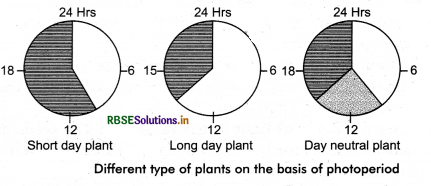
Critical Day Length or Critical Photoperiod
Critical photoperiod is that continuous duration of light which must not exceed in short day plants and should always exceed in long day plants in order to bring them to flowering. In other words critical photoperiod is that duration of light which is required for flowering in plant. In photoperiod, more continuous dark is required than that of light, because it has been proved by experiments that, certain light rays falling during dark period also affect flowering.
For example, Xanthium is a short day plant and has a critical photoperiod of 15 hours and Hyoscyamus niger is a long day plant and has a critical photoperiod of 11 hours. Even then Xanthium is a short day plant because in it flowering occurs it the photoperiod is less than 15 hours in 24 hours cycle, while Hyoscyamus is a LDP because for flowering it needs a photoperiod exceeding 11 hours. Both Xanthium and Hyoscyamus can flower if given a photoperiod of 14 hours, though they belong to different groups. Therefore, on the basis of day length it can not be determined whether the plant is SDP or LDP.
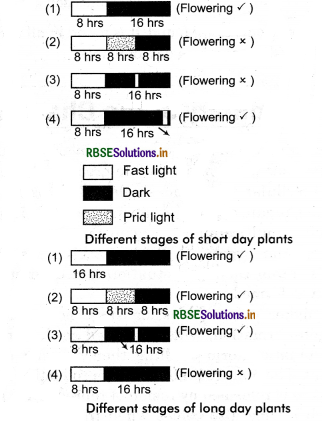
Process of Photoperiodism
Phytochrome absorbs light for induction to flowering process to synthesise flowering hormone florigen. This process is described as follow:
1. Absorption of light: The flowering in plants occurs when they get a suitable cycle of light and dark. The number of these cycles is different for different species. Xanthium pennsylvanicum requires only one photo inductive cycle for flowering. Salvia occidentalis requires 17 and Plantago lanceolata requires 15 photoinduction cycles for flowering. The flowering process in plants is possible only when they get required photo induction cycles. All the wavelength of light do not induce flowering. For flowering there most suitable wavelength is 560 nm - 640 nm.
2. Phytochrome: The wavelengths of light are absorbed by leaves. It is proved by this fact that there is no flowering in plant without leaves. Only single leaf also is sufficient to absorb required photoperiod. Partially matured leaves are most sensible for light.
Proteinaceous pigment phytochrome present in leaves absorbing light to induce flowering. Phytochrome is found in two forms. Pigment which absorb red light (660 - 665 nm) is called Pr, while one which absorbs for red light (730 - 735 nm) is known as Pfr. Both these forms of phytochromes are interchangeable due to their photochemical property.
Pr form of phytochrome absorbs red light and changes into Pfr form while Pfr form of phytochrome absorbs for red light and changes into Pr form. Pfr form changes slowly into Pr form of phytochrome in dark. In the day time plants store Pfr form. This form stimulates flowering in long day plants and inhibits flowering in short day plants. In dark Pfr form changes into pr form. Pr form promotes flowering in short day plants and inhibits flowering in long day plants.

3. Florigen: Flowering is caused by a hypothetical hormone florigen. This hormone is produced by leaves and transported to shoot at the time of flowering. Flowering in short day plants takes place as a result of the following process:

In leaves, substance ‘A’ is formed in the presence of light and CO2. This substance A’ is converted into ‘B’ in dark. The substance ‘B’ is ultimately changed into substance ‘C’. This substance ‘C’ produces the hormone florigen which is translocated to shoot region to promote flowering. If the substance ‘A’ does not get dark period then it changed into ‘X’ instead of ‘B’. Substance ‘X’ is a leaf forming substance and helps in vegetative growth of the plant.
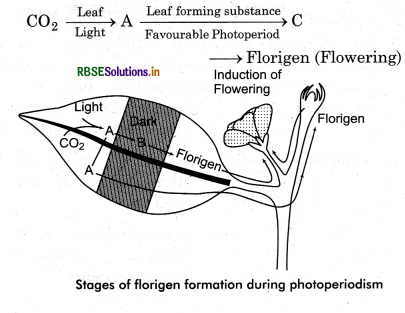
Question 4.
Describe factors affecting plant growth.
Answer:
The growth occuring per unit time is called growth rate. Therefore, growth rate may be represented mathematically. The growth can be represented by various forms. Such as arithmetic growth, geometric growth, sigmoid growth complete and relative growth.
(a) Arithmetic Growth: In arithmetic growth, the rate of growth is constant and increase in growth occurs in arithmetic orders. This type of growth is the simplest expression and can be seen in a root or shoot elongation in a constant rate. Among two cells formed after mitosis, only one cell goes in further division while other one differentiates and becomes mature. If this type of growth is represented on graph we find a liner line. This can be represented arithmetically,
Lt =Lo + rt
Lt = Length at time ‘t'
L0 = Lenght at time '0'
r = growth rate/ elongation per unit time.
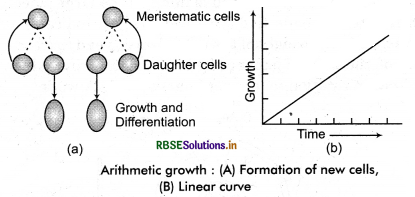
(b) Geometric Growth: The growth of a cell, an organ of plant or whole plant may not be same always i.e., it remains changing. In initial stage the growth is slower, which is called initial lag phase. Later the growth is rapid at an exponential rate which is called middle logarithmic phase. After this the growth becomes slower, it is called last stationary phase. It is collectively called geometrical growth. Such growth can be seen by growing unicellular organism in a nutrient containing medium. It refers to the division of both daughter cells obtained during mitosis, i.e., here both the progeny cells following mitotic cell division retain the ability to divide and continue to do so.
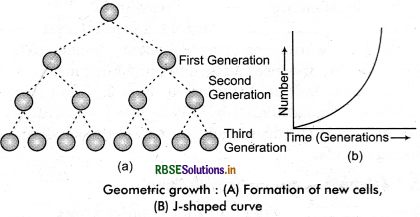
Geometric growth cannot be maintained for a longer period of time because some cells are dead and due to limited nutrient supply, the growth becomes slower leading to stationary phase. If we plot the parameter of growth against time, we get a typical sigmoid or S - shaped curve. Geometric growth can be represented in mathematical form of following:
W1 = W0ert
where, W1 = Final size (weight, height, number etc.)
W0 = initial size at the beginning of the period
r = growth rate
t = time of growth
e = base of usual logarithm
r is a relative growth, it is used for measurement of the capacity of formation of newly produced plant material by plant. If refers as efficiency index, thus final size of w1 depends upon initial size of w0.
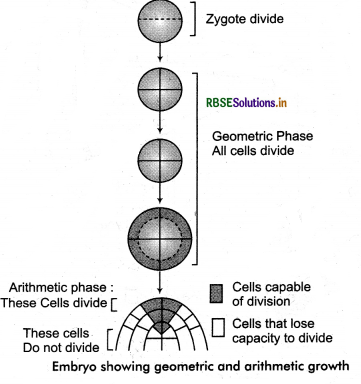
(c) Sigmoid Growth Curve: Gometric growth can be divided into three phases:
- Initial lag phase
- Middle log phase
- Last stationary phase
If we plot the parameter of growth against time, we get a typical sigmoid curve which has S - shape. A sigmoid curve has following four steps:
- Lag Phase: It represents initial stage of growth and has very slow growth rate. This period is comparable to the phase of cell division.
- Log Phase: This phase exhibits very fast growth rate and comparable to the cell enlargement phase.
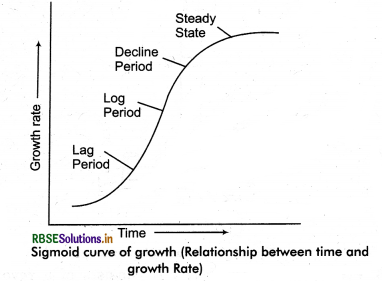
- Decline Phase: In this phase the rate of growth declines once again. Slowing down metabolic activities results in decline period of growth.
- Steady Phase: Growth almost complete and stops during this phase resulting in zero growth rate.
(d) Absolute and Relative Growth Rate:
- The measurement and the comparison of total growth per unit time is called the absolute growth rate (AGR).
- The growth of the given system per unit time expressed on a common basis, e.g., per unit initial parameter is called the relative growth rate (RGR).
In given figure both of leaves are gained equal growth in then total area in a definite time period, though, the relative growth rate of leaf A is more.
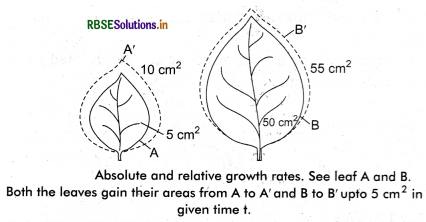
Question 5.
What do you understand by growth? Write different phases of growth.
Answer:
A permanent and irreversible change in the size or volume of a cell, organ or an organism accompanied by an increase in its dry weight is called growth. There arise change in size, difference in form and in complexity of organism is called development. Thus, growth is a quantitative condition in which increases in quantity of substances of living organisms. Growth and development cannot be easily separate to each other because these process occuring simultaneously in same organism.
Definition
According to Blackman, “growth is an outcome of excess of anabolic activities over catabolic processes of an organ or organism.”
According to Miller “growth is an incidence which represents permanent and irreversible change in the weight, size or volume of an organ of a plant”.
Actually, the permanent and irreversible change in a cell, tissue or in whole organism, thereby an increase in dry weight of organism is called growth.
Plant Growth Sites
In lower plants (e.g., algae, fungi etc.), growth occurs in their whole body while in higher plants, growth occurs in some specific parts. These specific parts have tissues which are called meristematic tissues. These tissues have immeasurable capacity of division.
On the basis of their position in plants, the meristematic tissues are of following three type:
(a) Apical Meristem: It occurs at the apex of root and shoot. The length of plant increases due to activity of apical meristem.
(b) Lateral Meristem: As clear by the name, these tissues are found in lateral parts such as, in lateral side of node and internodes, in basal portion of lateral buds etc., in
plants. There growth in thickness increases by the activeness of these tissue. Vascular cambium and cork cambium are its examples.
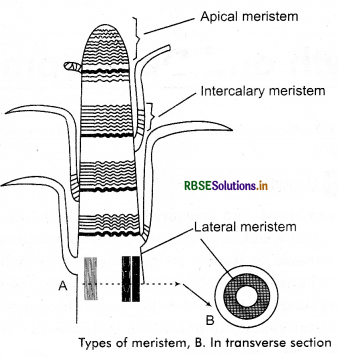
(c) Intercalary Meristem : This type of tissues mostly found on node. The length of internode of stem increases by the activeness of this tissue.
Question 6.
What do you understand by growth rate and growth curve. Explain.
Answer:
The growth occuring per unit time is called growth rate. Therefore, growth rate may be represented mathematically. The growth can be represented by various forms. Such as arithmetic growth, geometric growth, sigmoid growth complete and relative growth.
(a) Arithmetic Growth: In arithmetic growth, the rate of growth is constant and increase in growth occurs in arithmetic orders. This type of growth is the simplest expression and can be seen in a root or shoot elongation in a constant rate. Among two cells formed after mitosis, only one cell goes in further division while other one differentiates and becomes mature. If this type of growth is represented on graph we find a liner line. This can be represented arithmetically,
Lt =Lo + rt
Lt = Length at time ‘t'
L0 = Lenght at time '0'
r = growth rate/ elongation per unit time.
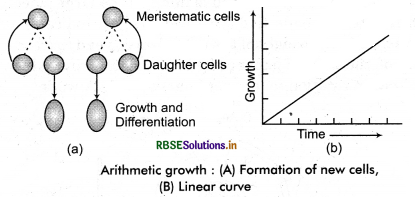
(b) Geometric Growth: The growth of a cell, an organ of plant or whole plant may not be same always i.e., it remains changing. In initial stage the growth is slower, which is called initial lag phase. Later the growth is rapid at an exponential rate which is called middle logarithmic phase. After this the growth becomes slower, it is called last stationary phase. It is collectively called geometrical growth. Such growth can be seen by growing unicellular organism in a nutrient containing medium. It refers to the division of both daughter cells obtained during mitosis, i.e., here both the progeny cells following mitotic cell division retain the ability to divide and continue to do so.
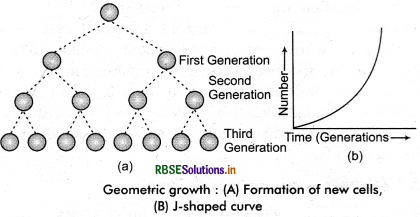
Geometric growth cannot be maintained for a longer period of time because some cells are dead and due to limited nutrient supply, the growth becomes slower leading to stationary phase. If we plot the parameter of growth against time, we get a typical sigmoid or S - shaped curve. Geometric growth can be represented in mathematical form of following:
W1 = W0ert
where, W1 = Final size (weight, height, number etc.)
W0 = initial size at the beginning of the period
r = growth rate
t = time of growth
e = base of usual logarithm
r is a relative growth, it is used for measurement of the capacity of formation of newly produced plant material by plant. If refers as efficiency index, thus final size of w1 depends upon initial size of w0.
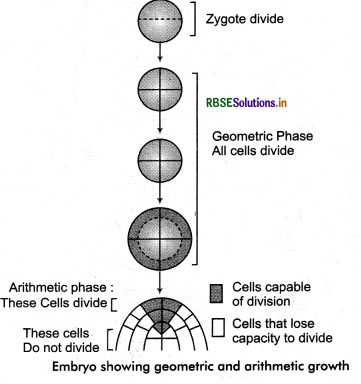
(c) Sigmoid Growth Curve: Gometric growth can be divided into three phases:
- Initial lag phase
- Middle log phase
- Last stationary phase
If we plot the parameter of growth against time, we get a typical sigmoid curve which has S - shape. A sigmoid curve has following four steps:
- Lag Phase: It represents initial stage of growth and has very slow growth rate. This period is comparable to the phase of cell division.
- Log Phase: This phase exhibits very fast growth rate and comparable to the cell enlargement phase.
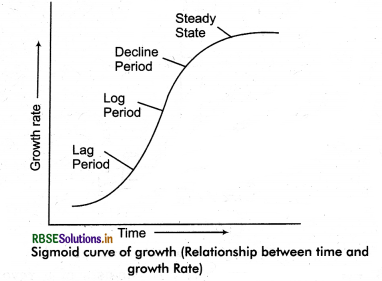
- Decline Phase: In this phase the rate of growth declines once again. Slowing down metabolic activities results in decline period of growth.
- Steady Phase: Growth almost complete and stops during this phase resulting in zero growth rate.
(d) Absolute and Relative Growth Rate:
- The measurement and the comparison of total growth per unit time is called the absolute growth rate (AGR).
- The growth of the given system per unit time expressed on a common basis, e.g., per unit initial parameter is called the relative growth rate (RGR).
In given figure both of leaves are gained equal growth in then total area in a definite time period, though, the relative growth rate of leaf A is more.


Question 7.
What are plant growth regulators? Describe any two plant growth regulators.
Answer:
Some special chemical substances also contribute to the growth of plants in addition to the food prepared by plants and minerals absorbed by them. These chemicals are produced in very little amount. These chemicals are produced in one tissue or organ of the plant and sent to other parts for growth and development. Such chemicalsubstances are known as plant growth regulators. These are also called plant hormones or phytohormones. The word “hormone” is derived from a greak work “hormao” which literally means to “stimulate”. Many organic compound also work as phytohormones.
A plant hormone may be defined as an organic substance which is produced in one tissue of the plant and transfer to another tissue where in small quantities it affects the physiological activities of the plant, especially growth and development (F.W. Went and Thiman; 1937). The word hormone was first of all used by Starling (1906). He used this term for some stimulating chemical substances.
Plant hormones or phytohormones can be divided into following five groups:
- Auxins
- Gibberellins
- Cytokinins
- Abscisic Acid
- Ethylene.
Question 8.
Write physiological effects of the following:
(a) Auxin
(b) Gibberellins
(c) Cytokinins.
Answer:
(a) Auxin:
- Auxins are well known to promote the elongation of the stem. It promotes the growth by elongation of cells behind the apical meristem.
- Growth in the lateral bud is inhibited when the apical bud of a tall plant remains intact. However, the lateral bud grows rapidly on the removal of apical bud.
- Suppression of growth in the lateral bud by apical bud due to auxin produced by apical bud in termed as apical dominance. The reason for this is due to auxin produced in growing tip and it stimulates growth but as it moves downwards, suppresses growth in the stems below.
- Auxin is responsible for initiation and promotion of cell division in the cambium, which is responsible for secondary growth. This property of induction of cell division has been exploited for tissue culture techniques and for the formation of callus.
- Auxin promotes the growth of root only at extremely low concentrations. At higher concentrations, it always inhibits the growth of the root.
(b) Gibberellins:
Gibberellin is one of the plant growth hormone which is required for the growth and development of the plants. The regulator is required for different processes.
- The hormone causes elongation in the stem.
- The hormone is responsible for the bolting effect in the rosette plants.
- The regulator is externally used for the removal of dormancy in the case of seeds and buds.
- Ther hormone promotes and stimulates seed germination.
- The hormone can be used as an alternative to vernalization.
- They promote flowering in the long day plants.
(c) Cytokinins.:
Cytokinins induce cell division and promote the growth of developing shoot buds, root apices, young fruits, etc. It promotes the development of lateral shoot and thereby helps in overcoming apical dominance. Cytokinins delay leaf senescence by promoting nutrient mobilisation.
